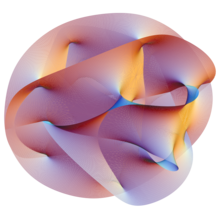AdS/CMT对偶
外观
在理论物理学中,AdS/CMT对偶(英語:AdS/CMT correspondence),全称反德西特/凝聚体理论对偶(英語:Anti-de Sitter/condensed matter theory correspondence)是指通过利用AdS/CFT对偶将弦理论应用到凝聚体理论中。
几十年来,实验凝聚体物理学家发现了许多物质的奇异状态,包括超导态、超流态和玻色–爱因斯坦凝聚态等。这些状态可以用量子场论来解释,但是一些现象使用标准的场论方法难以得到很好的解释。一些理论凝聚体物理学家希望AdS/CFT对偶可以用来描述这些系统,并更多地了解它们的性质。[1]
进展
[编辑]目前在解释超流体向绝缘体转变的问题上,弦论方法已经取得了一定的成功。超流体是一种由电中性原子组成的系统,流动时没有任何阻力。实验室中通常用液氦来产生这样的物质,但是最近实验物理学家发展了产生人工超流体的新方法:将数以万亿计的冷原子倒入交叉激光形成的格子中。这些原子最初表现出超流体的性质,但在激光强度增大的条件下最终转变为绝缘体。转变过程中,原子的性质十分不寻常,最近物理学家认为这可以表示一种对偶(英語:dual,不是correspondence):流体可以用类似于黑洞的场论来描述。[2]
质疑
[编辑]尽管许多物理学家开始使用弦论的方法来研究凝聚体物理学,一些这个领域的理论家对AdS/CFT对偶是否能为建立现实世界中系统的模型提供有效工具。在给《今日物理》(Physics Today)的一封信中,诺贝尔物理学奖获得者菲利普·安德森写道:[3]
| “ | 凝聚体理论中的AdS/CFT方法是一个非常宽泛的话题,我们可以关注最初的引导者“CFT”——共形场论。凝聚体问题总体上既不是相对论性的也不是共形的。在临近量子临界点时,时间和空间可能发生缩放,但是尽管这样我们还是有更好的坐标系,通常是晶格。有一些证据表明奇异金属左侧的其他线性T相与他们的推测可能相符,但是这种情况下凝聚体问题又是由实验事实超定的。[4] | ” |
参见
[编辑]注释
[编辑]- ^ Merali 2011, p.303
- ^ Sachdev 2013, p.51
- ^ Anderson, Philip. Strange connections to strange metals. Physics Today. [14 August 2013]. (原始内容存档于2013-08-15).
- ^ As a very general problem with the AdS/CFT approach in condensed-matter theory, we can point to those telltale initials "CFT"—conformal field theory. Condensed-matter problems are, in general, neither relativistic nor conformal. Near a quantum critical point, both time and space may be scaling, but even there we still have a preferred coordinate system and, usually, a lattice. There is some evidence of other linear-T phases to the left of the strange metal about which they are welcome to speculate, but again in this case the condensed-matter problem is overdetermined by experimental facts.
参考资料
[编辑]- Merali, Zeeya. Collaborative physics: string theory finds a bench mate. Nature. 2011, 478 (7369): 302–304. Bibcode:2011Natur.478..302M. PMID 22012369. doi:10.1038/478302a.
- Sachdev, Subir. Strange and stringy. Scientific American. 2013, 308 (44): 44. Bibcode:2012SciAm.308a..44S. doi:10.1038/scientificamerican0113-44.
- Sachdev, Subir. Condensed matter and AdS/CFT. 2010. arXiv:1002.2947
 .
.

